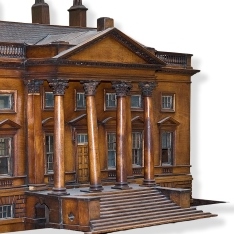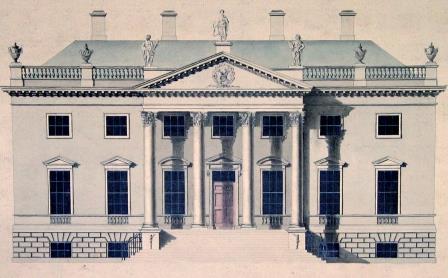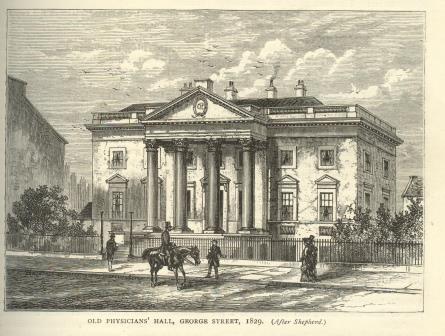
The architectural history of the College’s George Street hall, completed in 1781, has commonly been overlooked because it was demolished and deemed to have been a disappointment to both its owners and its architect, James Craig. The hall was actually intended to be part of a larger complex of buildings and rival Register House as the New Town’s most impressive public edifice.
Background
Before James Craig began work to plan and build the College’s hall and library between 1775 and 1776, the Royal College of Physicians of Edinburgh had indicated the extent of its ambitions with a series of aborted building projects between the 1750s and the 1770s, including a design by Sir James Clerk of Penicuick.
Clerk’s plan represented Rome’s Pantheon, and was intended to house meetings, a library and resident librarian, rooms for reading and research, consultations and waiting together with servants’ quarters, at the northern terminus of the new bridge over the Nor Loch. Designed in 1765, it was intended to be the New Town’s first public building. However, between 1767 and 1771, the College was asked to vacate this site for Register House. In response, the College first considered planning a new hall, library, cold bath and garden in the Old Town, but finally opted to relocate Clerk’s Pantheon complex to another New Town site on the south side of Princes Street – a project that was abandoned by 1773.
The George Street hall
In 1778 the College resumed its intention to build a new hall and library in the New Town, selecting a site on the south side of George Street and the architect James Craig as its designer. The intention was for art to be integrated into the building, with both the exterior and interior decorated with sculptures and paintings and for two large wings to be built to the east and west of the main building. The College had its choice ratified by Robert and John Adam, as well as Edinburgh Town Council.
Craig was already famous for planning the New Town, and was known to the College’s members and patrons. Among his friends, admirers and patrons were Sir Alexander Dick, Sir John Pringle, Dr John Hope and Dr William Cullen as well as the Earl of Bute, the Duke of Buccleuch and even King George III, who had approved of his New Town plan.
Abandoning the hall
By 1835 the College was contemplating selling Craig’s hall. Planning had begun in the 1760s and building in the 1770s, with the hall finally opening in 1781. This lengthy process, however, resulted in a building with a life span of only 54 years. At the time, the reasons given for abandoning the hall included its lack of space and warmth. Since then, the building has been perceived as a failure and as an example of Craig’s inability to manage a successful career.
Yet the reasons for the hall’s demise do not lie solely with its architect. The facts were that the College’s ambitions outweighed its ability to pay for the project’s completion and to secure enough land to build a grand hall with wings. In the 1770s Dr Hope reported that the College did not have enough income raised from membership subscriptions to sustain further extensive building campaigns, however desirable. Such ambitions also failed to grasp the fact that Edinburgh Town Council, though always sympathetic to the College, was administering the planning and building of the New Town and needed revenue to support itself following the Ayr Bank crash of 1772. This meant that it gave feus to the east and west of the hall to builders rather than to the College to develop into wings. Needing money to balance its accounts, the College even considered selling the building off in January 1781 to be redeveloped as the new Assembly Rooms. However, this proposal was not taken up and the College and its library moved into the building and set about finishing it off.
Still, it is Craig who often carries the blame for the demise of the George Street hall. Disputes over payments and his support of a journeymen’s strike in 1778–9 have been cited as weaknesses rather than strengths in Craig’s management of the building. These problems are better known than the ambitions behind and appearance of the hall, but they do not indicate the true quality of the building nor the admiration that some leading physicians had for it.
In 1835 both Dr Hope and Dr Spens objected to the proposed sale of the property, despite considering that the hall was too small and cold. Perhaps they, like Craig, had always thought the building ill-suited to the College’s needs once the wings had been abandoned – the project never being completed to either the College’s or architect’s full ambitions. Craig’s correspondence with the College between 1781 and 1782 is a sad account of his failure to complete the building, but it also indicates his desire to plan and build a great piece of architecture in the New Town.





